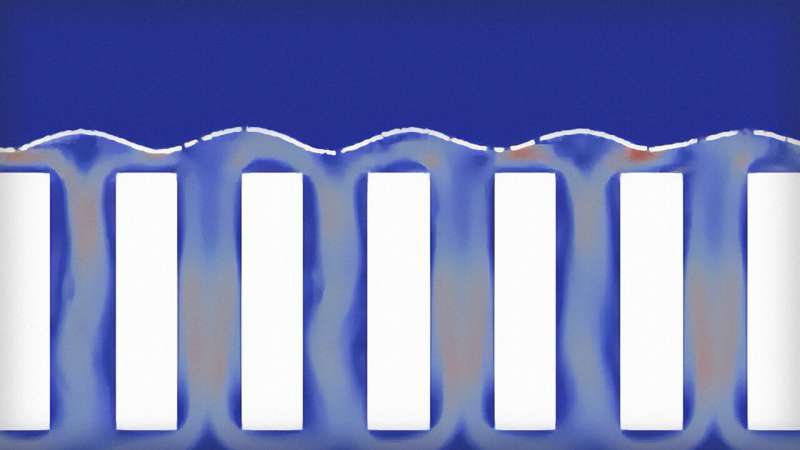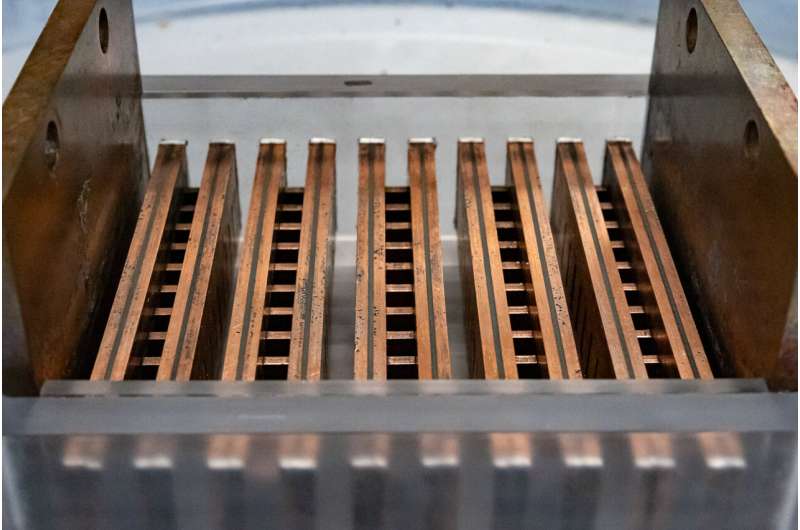This article has been reviewed according to Science X's editorial process and policies. Editors have highlighted the following attributes while ensuring the content's credibility:
fact-checked
trusted source
proofread
Creating loops of liquid lithium for fusion temperature control

Fusion vessels have a Goldilocks problem: The plasma within needs to be hot enough to generate net power, but if it's too hot, it can damage the vessel's interior. Researchers at the Princeton Plasma Physics Laboratory (PPPL) are exploring ways to draw away excess heat, including several methods that use liquid metal.
One possibility, say researchers at the U.S. Department of Energy Lab, involves flowing liquid lithium up and down a series of slats in tiles lining the bottom of the vessel. The liquid metal could also help to protect the components that face the plasma against a bombardment of particles known as neutrons.
"The prevailing option for an economical commercial fusion reactor is a compact design," said PPPL's Egemen Kolemen, co-author of a 2022 paper on the research and an associate professor of mechanical and aerospace engineering and the Andlinger Center for Energy and the Environment. However, compactness makes handling the heat flux and neutron bombardment a bigger challenge.
"Currently, there are no available solid materials that can handle these loads. Flowing liquid metals have the potential to resolve these materials challenges."
The liquid metal would only be directly exposed to the plasma's heat very briefly as it traveled across the top edge of a thin slat, driven by magnetic forces and an electric current. Then, the metal would flow down a channel created by the gap between two slats. As the liquid metal descends toward the bottom of the device, known as a divertorlet, the liquid would cool. Ultimately, the liquid metal would travel back up to the top of a slat, gather heat and fall again.
Flow loops minimize the liquid metal lost to evaporation
Experiments on this prototype for the cooling system were successful, and the results agreed with those shown in simulations. "We were able to replicate the flow loops around the slats, which is like the operational principle of the mechanism," said Francisco Saenz, a graduate student at Princeton's Department of Mechanical and Aerospace Engineering and co-author of the divertorlets paper.
"In the system we propose, the liquid metal heats up at the top surface, but it is displaced almost immediately by cool liquid metal that comes to the top surface to keep absorbing heat," Saenz said.
With each rise and fall around a slat, the liquid would heat up and be replaced with fresh liquid metal. However, the overheating of the liquid metal is minimized because the liquid metal is only exposed to the heat during its small trip over the divertorlet. Past designs for similar liquid metal systems, known as divertors, involved having the liquid metal flow directly past the plasma for a longer period of time, which would have likely resulted in overheating and more evaporation.
The lithium that moves into the plasma through evaporation could also be beneficial; based on past research at PPPL, it should help the plasma stay at high temperatures and be manageable.
"Lithium reduces the recycling of hydrogen particles. By recycling, I mean there are atoms from the plasma that leave the core, go to the walls and bounce back to the plasma," Saenz said. The isotopes that do bounce back have a significantly reduced temperature, which ends up cooling down the plasma's temperature. "But if your plasma-facing system is made of lithium, it absorbs and keeps those particles that are colliding against the walls, so your plasma is no longer cooling down at fast rates."

The researchers used galinstan—a mix of gallium, indium and tin—instead of lithium in their experiments. "The electrical conductivity of a liquid metal is one of the governing properties for flows under the influence of strong magnetic fields, like those you would find in a fusion vessel. Galinstan has an electrical conductivity that is pretty similar to that of liquid lithium," said Saenz, which allows them to do analysis of lithium flows in different scenarios.
The amount of current applied to the liquid was increased in a series of steps to see how it would impact the speed and uniformity of flow. Saenz said the research team achieved their target speed without the liquid metal splashing. The faster a liquid metal flows, the more a specific kind of force acts on it. This force, known as magnetohydrodynamic drag, slows the flow down.
Fortunately, their experimental results aligned with what they saw in simulations, and the researchers were able to get the liquid flowing below the 1 meter per second speed limit they set, using 900 amps of electric current efficiently. The ideal divertorlet would need to not only draw away heat, Saenz said, but do so without requiring an excessive amount of power to keep the liquid flowing.
Princeton University graduate student Brian Wynne, who also worked on the divertorlets project, is looking forward to future iterations of the prototype. "There is still more work to be done," Wynne said. "We need to optimize the structure of the geometry itself in terms of the shape of the slats."
That might involve reducing the width of each slat and rounding the edges to reduce the peaks and valleys seen in the fluid. The peak of one wave can block heat transfer to an adjacent valley, so creating a smooth surface should increase heat absorption from the plasma to the liquid.
Wynne said the next prototype might move from copper slats to 3D-printed tungsten, too. This highly durable metal is thought to be well suited for plasma-facing components, in general, so it might make sense to use it for the divertorlets, he said. Future prototypes also will investigate systems for flowing lithium in and out of the divertorlet. The current divertorlet prototype is a closed system, meaning no liquid lithium was removed or added while the current was applied.















